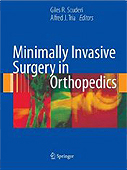- Sets the standard for major references in MIS
Includes the latest techniques
Integration of case studies and roundtable discussions is unparalleled
Valuable as a stand-alone reference and also as complement to Drs. Scuderi and Tria’s MIS Techniques in Orthopedics
and MIS of the Hip and Knee: A Clinical Perspective
The growth of minimally invasive surgery (MIS) in orthopedics has been dramatic worldwide, as clinical results indicate
that patients who undergo MIS procedures typically experience minimized blood loss, smaller incision scars, shorter
hospital stays and quicker rehabilitation. Minimally Invasive Surgery in Orthopedics serves as the single-source
reference in the field, compiled by recognized authorities and filled with information about even the most challenging
MIS techniques. The book is divided into sections that focus on the shoulder and elbow, the hip, the knee, the foot and
ankle, the spine, as well as computer navigation, and each section is heavily illustrated and clearly written for ease
of understanding. Orthopedic surgeons, residents, and fellows who want to truly understand MIS will find this thorough
text invaluable.
What is minimally invasive surgery and how do you learn it?.- Section I. The Upper Extremities.- Overview of shoulder
approaches: choosing between mini-incision and arthroscopic techniques.- Mini-incision bankart repair.- Mini-open
rotator cuff repair.- Minimally invasive treatment of greater tuberosity fractures.- Mini-incision fixation of proximal
humeral four-part fractures.- Mini-incision shoulder arthroplasty.- Overview of elbow approaches: small incisions or
arthroscopic portals.- Mini-incision medial collateral ligament reconstruction of the elbow.- Mini-incision distal
biceps tendon repair.- Minimally invasive approaches for complex elbow trauma.- Minimally invasive approaches for
latereal epicondylitis.- Overview of wrist and hand approaches: indications for minimally invasive techniques.-
Minimally invsaive fixation for wrist fractures.- Endoscopic and minimally invasive carpal tunnel and trigger finger
release.- Round table discussion of minimally invasive surgery upper exteremity cases.- Section II: The Hip.-
Anterolateral mini-incision total hip arthroplasty.- Minimallyy invasive total hip arthroplasty with the anterior
surgical approach.- The Watson-Jones approach to minimally invasive total hip arthroplasty.- Posterolateral mini-
incision total hip arthroplasty.- Minimally invasive approach to metal-on-metal total hip resurfacing arthroplasty.-
MIS approach for hip resurfacing.- Minimally invasive total hip arthroplast using the two-incision approach.- Round
table discussion of mini-incision total hip arthroplasty.- Section III: The Knee.- MIS undicondylar arthroplasty: the
bone-sparing technique.- Minimally invasive surgery for the unicondylar knee arthroplasty: the intramedullary
technique.- MIS unicondylar knee arthroplasty with the extramedullary technique.- MIS arthroplasty with the UniSpacer.-
MIS TKA with the limited medial parapatellar arthrotomy.- MIS TKA with a subvastus approach.- Mini-midvastus total knee
arthroplasty.- Minimally invasive total knee arthroplasty: suspended leg approach and arthroscopic assisted techniques.-
Quadriceps sparing total knee arthroplasty.- Minimally invasive quadriceps sparing total knee replacement preseving
the posterior cruciate ligament.- Bi-unicompartmental knee prostheses.- MIS patellofemoral arthroplasty.- Round table
discussion of MIS total knee arthroplasty.- Section IV: The Foot and Ankle.- Percutaneous repair of acute rupture of
Achilles tendon.- Endoscopic gastrocnemius recession.- Percutaneous reduction and internal fixation of the Lisfranc
fracture-disclocation.- Arthroscopic subtalar arthrodesis: indications and technique.- Minimally invasive ankle
arthrodesis.- Arthroscpic ankle arthrodesis.- Endoscopic calcaneoplaasty.- Arthroscopy of the first metatarsophalangeal
joint.- Arthroscopy of the first metatarsophalangeal joint.- Endoscopic plantar fasciotomy.- Uniportal endoscopic
decompression of the interdigital nerve for Morton''s neuroma.- Percutaneous Z Tendo Achillis lengthening.-
Percutaneous distraction osteogenesis for treatment f brachymetatarsia.- Minimally invasive realignment surgery for the
Charcot foot.- Percutanous supramalleolar osteotomy using the Ilizarov/Taylor spatial frame.- Hallux valgus surgery:
the minimally invasaive bunion correction.- Minimally invasive closed reduction and internal fixation of calcaneal
fractures.- Minimall invasive ORIF of Calcaneal fractures.- Minimal dual incision ORIF of the calcaneus.- Percutaneous
screw fixation of hallux sesamoid fractures.- Proximal percutaneous harvesting of plantaris tendon.- Percutaneous ORIF
of periarticular distal tibia fractures.- Round table discussion of MIS of the foot and ankle.- Section V: The Spine.-
Minimally invasive spinal surgery: evidence based review of the literature.- Endoscopic foraminoplasty: key to
understanding the sources of back pain and sciatica and their treatment.- Minimally invasive thoracic microendoscopic
discectomy.- Minimally invaasive cervical foraminotomy and decompression of stenosis.- Minimally invasive thoracic
microendoscopic discectomy.- MISS treatment of spinal deformity.- Percutaneous vertebral augmentation: vertebroplasty
and kyphoplasty.- Round table discussion of MIS spine surgery case.- Section VI: Computer Navigation.- CAOS: pros and
cons.- Computer-guided total hip arthroplasty.- Computer navigataion with posterior MIS total hip arthroplasty.-
Minimally invsive total knee arthroplasty with image-free navigation.- The utility of robotics in total knee
arthroplasty.- Electromagnetic navigation in total knee arthroplasty.- Computer navigation in foot and ankle surgery.-
Robotics in total knee arthroplasty


